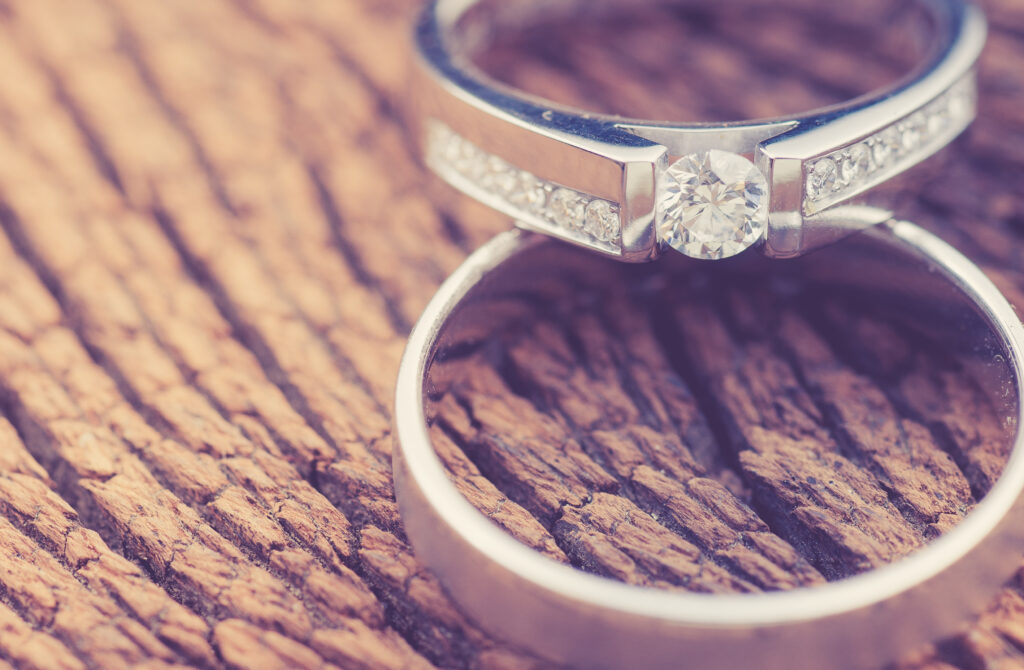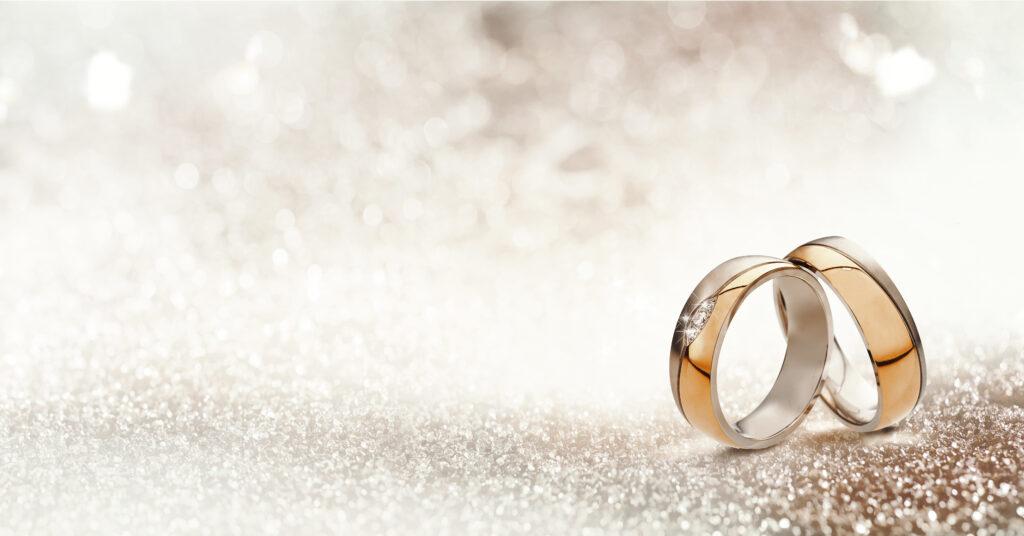If you’re looking for a wedding band, first of all, congratulations to you and your future spouse!
There’s already so much to plan and prepare for, but the crucial first step of picking out each other’s rings will hopefully be a smooth shopping experience.
You need to consider a variety of measurements when you’re shopping for wedding bands, including the width and thickness.
On average, men’s wedding bands are 6-10 mm wide, while women’s are 3-5 mm. Women’s bands tend to be thinner because they are often worn alongside an engagement ring. The average thickness for wedding bands is about 1.5mm. This is best for daily wear and active work.
Choosing a good band width is important because a wedding ring should be comfortable for long-term use.
The featured topics in this article are the average band ranges, common widths people find comfortable, the differences between wedding rings vs. bands, and a band’s thickness and width.
There are lots of interesting wedding ring notes to take in but we’ll help guide you through this process!
Average Wedding Band Ranges
Wedding bands range from 1mm at the thinnest and 12-15mm at the widest.
The most common wedding band width for women is between 3-4mm widths because they are seen as elegant and thin.
They also are small enough that you can wear an engagement ring on the same finger.
Traditional and Unique Band Choices For Women
Engagement yet non-traditional bands for women can be as wide as 6mm.
For a more stylish, petite look women’s wedding bands go for 1-2mm in width.
However, extremely thin rings such as 1mm widths are more fragile and are likely to warp or break more easily.
A popular choice for both durable and lovely observing is the “pasta” band that is 3mm in width.
This style tends to be more fitting with a single gemstone.
Another popular band is the 4mm ring for those who prefer a not-as-thick choice as it also works as a bigger size so future resizing is avoided.
The 5mm band is also not super wide nor thin for a more gentle look while proudly displaying the gemstone.
Traditional Yet Masculine Band Choices For Men
Depending on what your career is you will most likely want something that looks good, wears out very slowly, and feels good on your finger.
Some men go for flexible rings that have more breathing room like Groove rings or stick with the traditional gold or titanium look with a ring between 6mm-8mm.
Lastly, some widths go from 6mm-12mm.
The 6mm is thick to be able to work with several designs while having better resistance.
Rings that are 7-12mm are as wide as ring bands can get and are usually reserved for men’s rings.
What Wedding Ring Width Is Best?
Choosing a definitive “best” size for rings is difficult because everyone has different finger sizes, comfort levels, and design preferences.
However, there are some good guidelines to follow that will help you find a ring that you like, but also make sure it’s sturdy enough to last the test of time.
Trying on prospective bands will help you find out which styles and sizes you prefer.
If your fingers are small, chances are you want a thinner band width. If your fingers are fairly big, a thicker band would likely be a better match.
However, if you want your wedding band to match your spouse, the 6-8mm range is where both ring types overlap for men and women.
For better lasting wear it’s best to find metal like titanium or tungsten.
Sterling silver tends to not be a strong choice, though it depends on where the ring is made.
By having a stronger band the wear and tear become minimal to non-existent.
It is normal to think that having a thicker band would be uncomfortable, but that’s not always true as even small rings can sometimes tighten uncomfortably and cut off circulation.

Thickness Vs Width On Wedding Bands
The terms of thickness and width are often confused when it comes to wedding bands.
They refer to different measurements.
A ring’s width is how wide it is (aka how much much of your finger it covers when viewed from above).
On the other hand, a ring’s thickness is related to how thick the overall band is.
So if you looked at a ring from the side, how far above your finger would it rise?
Something to remember when you are looking into the width of the ring is how wide the ring will be overall.
A jeweler will have a caliber for measuring the diameter of your finger to help with the ring sizing or an array of ring moldings for both size and width preference.
A popular choice for a thick-width ring is a tungsten ring, though keep in mind that tungsten rings are heavier than traditional gold.
For a better visual guide on ring widths visit this guide.
Wider wedding bands tend to be more uncomfortable than bands that are built to be narrow.
Wide bands do fit more snugly on a finger so it’s best to plan for one size bigger so the freedom of taking off the ring is smoother.
Those who have large knuckles have felt better comfort with a 4mm and lower narrow-fitted band.
Once the band gets over the knuckle, the base of the finger will feel looser.
Having your wedding bands stacked will look impressive but it also should be taken into account how wide you want that stack to feel.
On the style side, the trend is to match the wedding band’s width with the band of the engagement ring to be twice as wide.
If your engagement ring is narrow, it will look superb when paired with a narrow wedding band.
An engagement ring and a wedding band with mismatched widths and thicknesses will look out of place.
The thickness of a ring makes a difference in its overall durability.
If it’s not already featured on the band, a .25mm increase is given to significantly extend the ring’s durability against wear and tear.
If your ring does stay at 1.5mm and is bending or changing shape, don’t worry, this is normal.
Having the ring become oval-shaped can even make for better comfort.
If your ring becames misshapen, you can always resize the ring back to how it was for a fee depending on the metals used (platinum being the most expensive whereas yellow gold/sterling silver are the cheapest).
Those who have long, slender fingers tend to feel more comfortable with thin bands that feel slim around the finger.
Beware of thinner bands though as they can occasionally feel slightly sharp around the edges (depending on the shape).
In terms of what thickness you should choose for a wedding band, make sure it doesn’t look overwhelming next to the engagement ring.
Your safest bet is to have the wedding band be 1.25mm thick if the engagement ring’s thickness is 1.5mm.
The trick is to make the top (engagement) ring thicker than the bottom (wedding) band or match what the rings look like in the middle.
Common Wedding Band Widths
Below are featured width ranges for both men’s and women’s rings:
| Men | 4mm | 6mm | 8mm | 10mm | 12mm | 20mm |
| Women | 2mm | 4mm | 6mm | 8mm | 10mm | 12mm |
Wedding band widths can be as small as 2mm or wide as 20mm.
If you’re not accustomed to wearing rings on your finger, it can be hard to get an exact vision of how good width is without going in to try rings on.
*A tip for women: Also keep in mind that your wedding band should match the width of your engagement ring otherwise it’ll look like a mismatched set.
Depending on the width of the engagement ring it’s best to go with a width of 2mm.
However, this comes down to what you want.
Whether you want a lovely engagement ring with a simple band or a single gemstone ring with a thicker band, it’s all up to you.

Nowadays some people are known to stack up to 3 wedding bands using an array of designs and metal preferences.
Having a wedding band width that’s 6mm is a good choice for men who have small hands with thin fingers whereas an 8mm wedding band width or more is a great fit for women who have larger hands.
Modern styles tend to do better with bigger widths (10mm, 12mm 20mm) not just for wedding bands but rings for fashion purposes as well.
There are also major advantages to having a single ring being both the wedding and engagement ring.
Having two rings can cause additional wear and tear on the rings.
Single rings have less fuss when shopping and there are jewelry designers that truly have some lovely pieces out there.
It’s also one less ring to worry about losing while also saving exorbitant amounts of money paying for another.
So long as your wedding band and engagement ring show the withstanding of time of the beautiful love you share between you and your spouse (metaphorically and physically), that’s all that should matter.
When Should You Resize Your Wedding Ring?

The easiest and cheaper option when resizing your wedding ring is resizing down.
You can resize your wedding ring by adding extra pieces of material and placing them on the bottom.
This ends up making the ring two sizes bigger and you would be paying for the jeweler’s craft and material.
If you resize up you’d be looking at an extra cost based on the material needed, sometimes twice the original price from the ring’s material.
The best thing to do is get a slightly larger ring and if needed, resize it down. Source
The following are observations made from the following source on what different ring metals could cost in resizing:
The toughest metals to work on are platinum-based rings as they give jewelers a hard time with resizing because of the different tools while burning gas in order to get it just right.
If you plan on resizing up your platinum ring you’d be looking at paying at least $100-$300.
Resizing down will be cheaper but you should expect to pay about $60-$100.
White gold rings result in your cost being more centered around material needs than work effort.
Rings like this have a layer of rhodium plating that comes off during the melting process during resizing.
When including the re-plated rhodium, resizing up or down can be between $60-$130 for white gold rings.
Yellow gold rings are in the middle with resizing costs because gold is softer and easier to mold for jewelers.
The only work needed is soldering and polishing so an expected resize up and down cost varies around $40-$100 on yellow gold rings.
The cheapest option for resizing rings is the sterling silver-based material because of the cheap cost of silver being $17.20 per ounce.
This results in the sterling silver resizing being around $20-$40.
In the end, how wide your wedding band should be really comes down to your personal preferences.
If you like the look of a certain band and you like how it looks on you, then get it regardless of how wide or thick it should or should not be.
While there are general standards for how to pair wedding bands and engagement rings together to make a cohesive pair, you may find a wedding band that you fall in love with that doesn’t follow those ideals.
The important thing here is that you like how it looks and that you enjoy wearing your rings.
While there is plenty of advice on how to pick rings out, remember, it is your wedding and your wedding band.
Don’t settle on a band you don’t like because a jeweler says it looks better with your engagement ring than the one you really like.
Wedding bands should be a symbol of your bond with your spouse and you should be proud to wear your rings every day.



